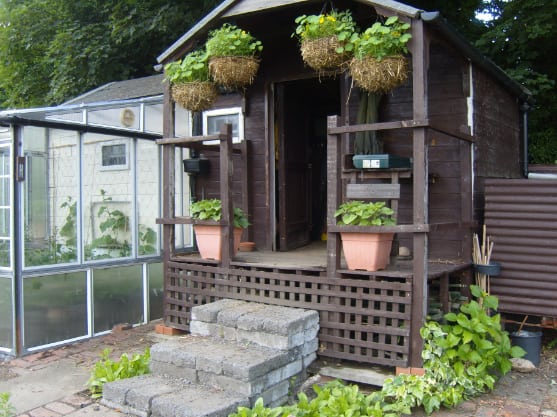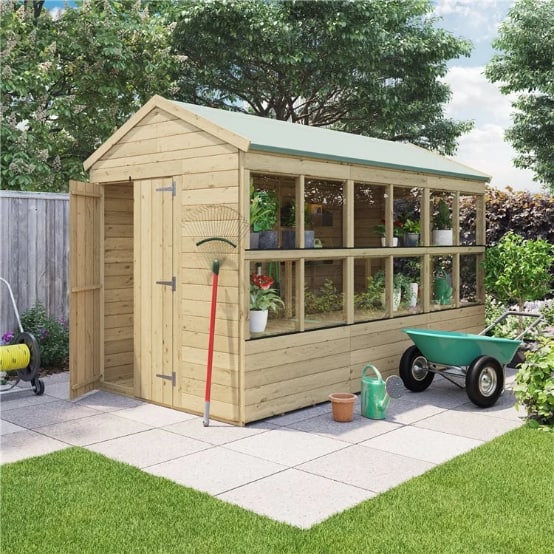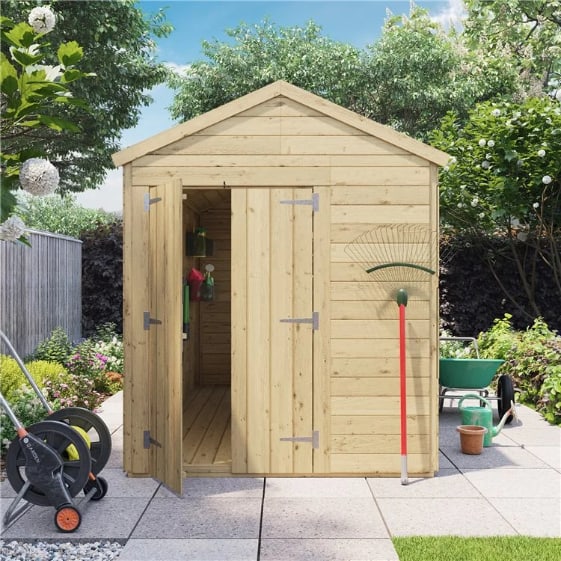Jump to:
Allotment gardens present the possibility of cultivating within the humble confines of sheds. In this guide, we’ll discover how to create one and make room for your garden tools and a place for your green projects. From planning to designs and personal touches, this blog is your blueprint. Read on, and let’s transform a simple shed into a gardening haven!
Planning Your Allotment Shed

(Image Credit: Wikimedia Commons)
Planning is the cornerstone of creating an effective and functional allotment shed. Before embarking on construction, it helps to understand the significance of careful planning.
Begin by evaluating the size of your allotment. You’ll also want to take the time to research local regulations to ensure compliance. This step helps you determine the permissible dimensions and placement of your shed. Most importantly, it avoids legal complications, saving you the headache.
Equally important is aligning the shed with your specific gardening needs. Consider the types of tools and equipment you’ll store. Do you need a dedicated workspace for potting and gardening activities? If so, what are the requirements? How the shed can enhance your overall gardening experience. Imagine incorporating a potting bench in your wooden shed for convenient seedling work. Or installing customised shelving for organised tool storage. These additions not only streamline tasks but also elevate your gardening pleasure.
When you plan carefully, you create a shed that fits well in your allotment. This, in turn, makes it practical and efficient for your gardening activities.
Shed Design and Layout

When choosing a shed design for your allotment, consider the size, material, and style. Consider the available space in your garden and the amount of equipment you need to store. Plus, your aesthetic preferences. Opt for a size that accommodates all these to complement your vision for your allotment shed. When it comes to the materials, choose from traditional wooden and/or modern metal sheds. Or even repurposed materials for an eco-friendly touch, to add.
Plan the interior layout of your shed strategically. Utilise shelves, hooks, and storage bins to keep gardening tools organised. Create designated areas for potting and working on projects. A well-thought-out layout ensures easy access to tools. It also maximises the functionality of the space, making gardening tasks more efficient.
Position your shed to receive ample natural light. This aids plant growth and creates a pleasant workspace. Incorporate windows, skylights, or even transparent roofing materials to enhance daylight. Adequate ventilation is crucial to prevent dampness and maintain a healthy environment. Also, ensure proper airflow through vents or windows. This technique promotes a fresh and conducive atmosphere within your shed.
Essential Features
Equip your allotment sheds with features like sturdy shelving for organised storage. You can also never go wrong with hooks for hanging tools. A practical workbench offers a dedicated space for potting, maintenance, and other tasks. This includes transplanting and seedling work, promoting efficiency. Adequate tool storage also prevents clutter. Plus, prolongs the lifespan of your equipment by protecting them from damage.
Safeguard your tools and equipment by implementing security measures. Install sturdy shed locks and consider reinforced doors and windows. Also, ensure the shed is well-lit. Additionally, marking your tools and employing motion-activated lights can act as deterrents. This approach adds an extra layer of protection for your valuable gardening assets.
Sustainable and Eco-Friendly Options
Embracing eco-friendly practices not only helps the environment but also boosts sustainability. Begin by exploring materials with minimal environmental impact for the construction. Consider reclaimed wood, bamboo, or recycled metal. Doing so ensures your shed has a smaller carbon footprint. (Note: This step is optional if you already have an existing garden shed.)
Additionally, consider rainwater harvesting systems to water your plants. Place rain barrels under downspouts to collect rainwater efficiently. Ensure lids are secure to prevent debris and mosquitoes. Use a fine mesh screen to filter out impurities. Regularly clean and maintain to ensure a sustainable and clean water source.
Integrate composting options, such as a closed-loop system for organic waste. To DIY, consider repurposing a bin or constructing a designated composting area. Toss kitchen scraps, yard waste, and organic matter into the compost. A few months later, it will turn into nutrient-rich soil for your garden.
Finally, emphasise the importance of using recycled or repurposed materials. Not only for construction but also for interior fittings, promoting a circular economy. Source recycled or repurposed materials for shed construction and interior fittings. Salvage wood, metal, or other materials from previous projects or repurpose old furniture. By doing so, you minimise waste and reduce your environmental impact.
Personalising Your Allotment Shed

Make your shed uniquely yours by adding creative touches that showcase your style. P{aint the exterior in vibrant hues or earthy tones to evoke a welcoming atmosphere. Embrace decorating options such as personalised signs and vintage garden tools. If the space allows, include repurposed furniture, such as a garden bench.
Transform the shed into a canvas for self-expression with murals or stencils. Perhaps a living roof adorned with succulents. Utilise vertical space by hanging potted plants, tools, or decors on walls. Let your allotment shed be a canvas for your creativity, making it an inspiring space.
Maintenance
Maintaining your allotment shed ensures it remains a functional and durable space. Conduct regular checks for leaks by inspecting the roof and walls. Examine the structure for signs of wear, reinforcing weak areas to prevent damage. Address any issues right away.
Implement pest control measures. Seal gaps and use safe deterrents to protect your tools. Seasonal maintenance is also crucial. Clean gutters in fall and remove snow buildup in winter. Treat surfaces with wooden shed treatment to prevent weathering.
Organise tools and equipment systematically, making them easily accessible. Consider installing hooks, shelves, and storage bins for efficient use of space. With these practical tips, you ensure your shed stands the test of time!
Round-up
Creating the best allotment shed requires careful planning, design, and maintenance. Use eco-friendly materials, add personal touches, and ensure regular upkeep. Each of these steps ensures to enhance your gardening joy. Paired with sustainable practices and essential features, your allotment shed will be ready. Are you ready to start your shed project and turn it into a space where gardening meets creativity?
If you’re still searching for the perfect shed, explore our available garden sheds for sale. Garden Building Direct also provides potting sheds, enhancing your gardening experience.
Up next on your reading list: How to Organise a Potting Shed Interior – 10 Tricks and Ideas










